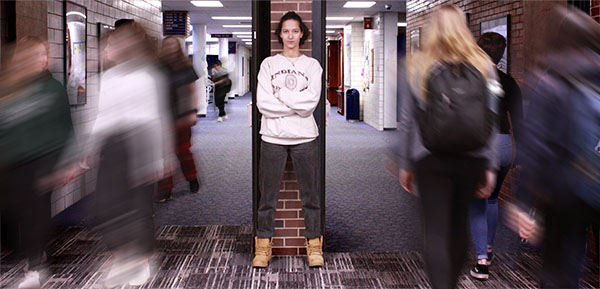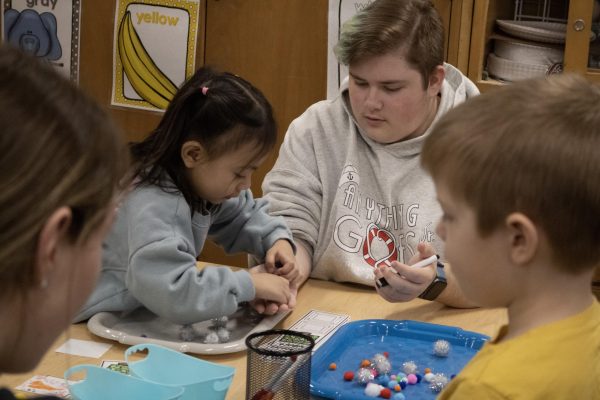“You don’t belong here.” Transgender students reveal stigmas pertaining to gender non-conformity, find pride in identity

Photo illustration by Nicole Surcel and Ellie Ruos
Junior Dakota Betts stands strong as they hear microaggresions about transgender students that are ignorant of the identity struggles they face on a day-to-day basis.
December 20, 2019
Thirty-two percent of the student body believes transgender students at South face stigmas around their gender identity, whereas 56 percent believe that they do not, according to an unscientific survey of 282 students conducted by the Oracle. Sophomore Sam Jones*, who is non-binary and uses they/them pronouns, believes that even though South is portrayed as an accepting and diverse community, that’s not always the case under the surface.
“I feel like people only look at the numbers,” Jones said. “They look at how many people of different races go here, of different genders go here, of different economic backgrounds go here. You see all these numbers and you’re like wow, this school is very diverse. But in reality, is it accepting? Not really.”
Junior Dakota Betts, who is non-binary and uses they/them pronouns, believes that the microaggressions stem from the discrepancies between values that the school holds and the actions and words of some students. Betts explained that while they’re appreciative of their teachers’ respect toward their identity, they wish the student body reflected the administration’s attitude.
“It becomes an issue when the teachers are preaching one thing and students believe something else,” Betts said. “It’s hard to ask the school to do something to change this because there’s no way it would be met with any degree of acceptance by the people it would be targeting.”
Likewise, Walker believes that there is a sense of ignorance at South regarding attitudes towards transgender students that, although not particularly intentional, can be very damaging.
“It’s a smaller portion of kids who [openly] call people f****t in the hallways, but I think they don’t realize what they’re saying,” Walker said. “I think there’s a culture of ignorance in terms of ‘if this person doesn’t know, then they can say that.’ But that’s not true. I don’t think most people come to school thinking ‘I’m going to make that trans kid feel bad about himself.’”
Matthew Bertke, SAGA co-sponsor and French teacher, expressed that despite students’ struggles, his hopes are high for South’s future: with the establishment of the gender-neutral bathrooms and board policy requiring the honoring of transgender students’ consistent use of preferred pronouns, he believes South is making the right steps to becoming a more welcoming place.
“We are one of the schools in the country that is leading the way [to acceptance],” Bertke said. “Do we have ways that we could be better? Absolutely. There are always going to be ways we can learn and grow and our administration is happy to receive feedback about how we can continue to support all communities in our buildings.”
Freshman Agatha Mitchell has personally experienced South’s willingness to grow herself. Mitchell is gender fluid and uses both she/her and they/them pronouns, and when they first came out as genderfluid in middle school, they received rude remarks and slurs, though they haven’t experienced it yet in their short tenure at South, they shared. Mitchell has two pins on her backpack, one for each of the pronouns she uses, and her English teacher commented on them one day.
“My English teacher actually brought up the pins on my backpack and I wasn’t super prepared [to come out], but I did so anyway,” Mitchell said. “She asked ‘what are your preferred pronouns?’ and I said ‘I use both but she/her is fine since a lot of people are used to that.’ People have been trying to use they/them pronouns for me more often, which I do appreciate. It comes out so natural for a lot of the students and it’s really nice to see and hear.”
Nevertheless, challenges persist for some like freshman Zach Fox* who was born female and now identifies as male, though he shared that his identity is very fluid. Fox came out when he was in middle school and, like Mitchell, received more directly transphobic remarks at his old school than at South. What Fox struggles with the most is being misgendered.
“When you get misgendered it feels [invalidating] and so painful,” Fox said. “People [see you] as this one person and you want to be seen as who you really are. I’ve been struggling with gender dysphoria almost my entire life, I always felt super uncomfortable in my body.”
Jones explained that people usually understand what a binary-trans person is, i.e. male to female and female to male, but are generally not as informed of identities outside of the gender binary.
“People are mostly understanding of what a trans person is,” Jones said. “But they also have assumptions that come with it. Anything out of [the binary] they just think is really stupid and crazy. People won’t get it, but that’s okay as long as they’re being as respectful as they can be.”
Mitchell agrees with Jones that the stigma surrounding non-binary identities comes from misunderstanding what it means to be non-binary; because the subject of sexuality is discussed more often than gender identity, Mitchell said that they find it easier to be more public about their sexuality than their gender identity.
“I have quite a few trans friends and non-binary friends and the fact is that we have to [hide those] parts of ourselves,” Mitchell said. “It’s something that needs to be brought into the conversation in some way.”
Senior Logan Baldwin, who is a transgender male, shared that while he struggled with gender dysphoria most of his life, he believes life is much harder for transgender students who don’t fit the gender binary of being either a woman or a man.
“I feel like people who are transgender but don’t necessarily fit into a binary, those are the people who struggle because they can outwardly present as male and identify as somebody completely different,” Baldwin said. “That’s when it becomes very hard for other people to understand. So I think that in my case it’s a little bit easier because my gender connects with my expression.”
Betts shared that they often find combating the various stigmas and microaggressions difficult at times.
“I was in a class and these people were sitting behind me and they were making the joke, ‘Oh I identify as an attack helicopter,’” Betts shared. “I guess I was having a rough day, I turned around and said ‘Don’t say that. That’s messed up, and you don’t understand what that means to people. Knock it off.’ I think that it’s hard because as soon as you put yourself into that situation, people automatically make all these assumptions about you in that one second.”
Fox believes that the stigma here at South is a part of a worldwide issue because the discussion around gender identity is relatively new. Fox said that more education in classes such as history would solve the root of most transphobia: ignorance.
“I used to work with a gender counselor at the Lurie’s Youth Service downtown [Chicago] and she does clinics around schools that talk about gender dysphoria, gender identity, and gender nonconformity,” Fox said. “They come in and do presentations in classes. If more people were informed about what [gender identity] is and who people like me are, that would help a lot.”
Additionally, it would be more valuable for cisgender student allies as well as the administration to stand up for transgender students when they hear transphobic comments, Fox said.
“It’s better to see [the perspective] from people who are like them,” Fox said. “If there are cis people who are being rude and cis people who are trying to inform them, it’s a little bit easier cause they’re like each other.”
Baldwin has been identifying as transgender for many years, so he is comfortable being out and expressing his identity, he said. However, being transgender is one aspect of Baldwin’s life. It’s not everything that he is.
“[My gender identity is] a part of me but it doesn’t define me,” Baldwin said. “That’s the biggest thing that is hard for people to understand. They think this is all I am: somebody who’s confused and doesn’t know what they’re doing. I am a person who happens to be transgender, living on the earth just like you.”
*Names have been changed.













